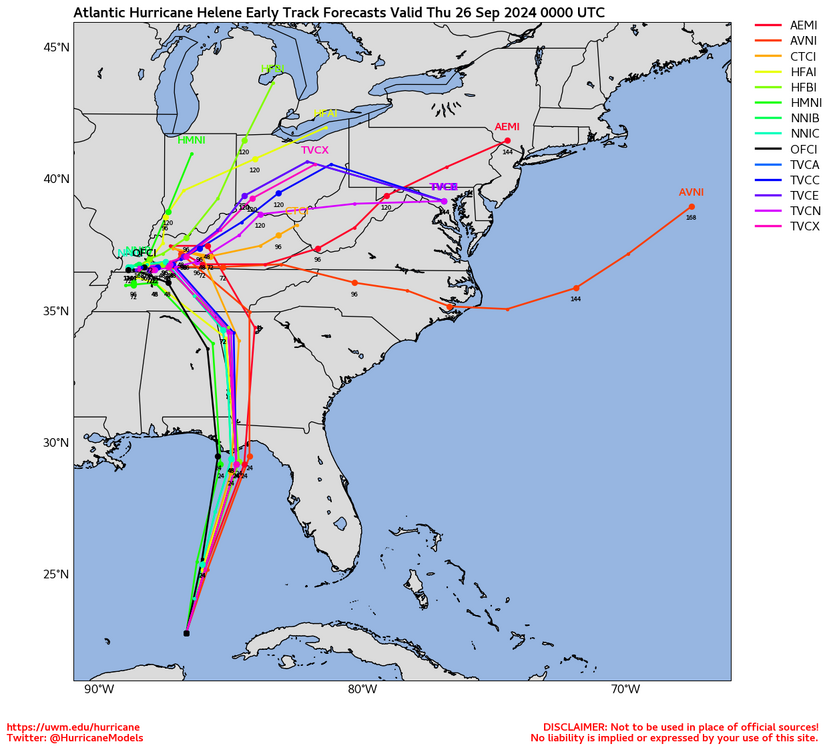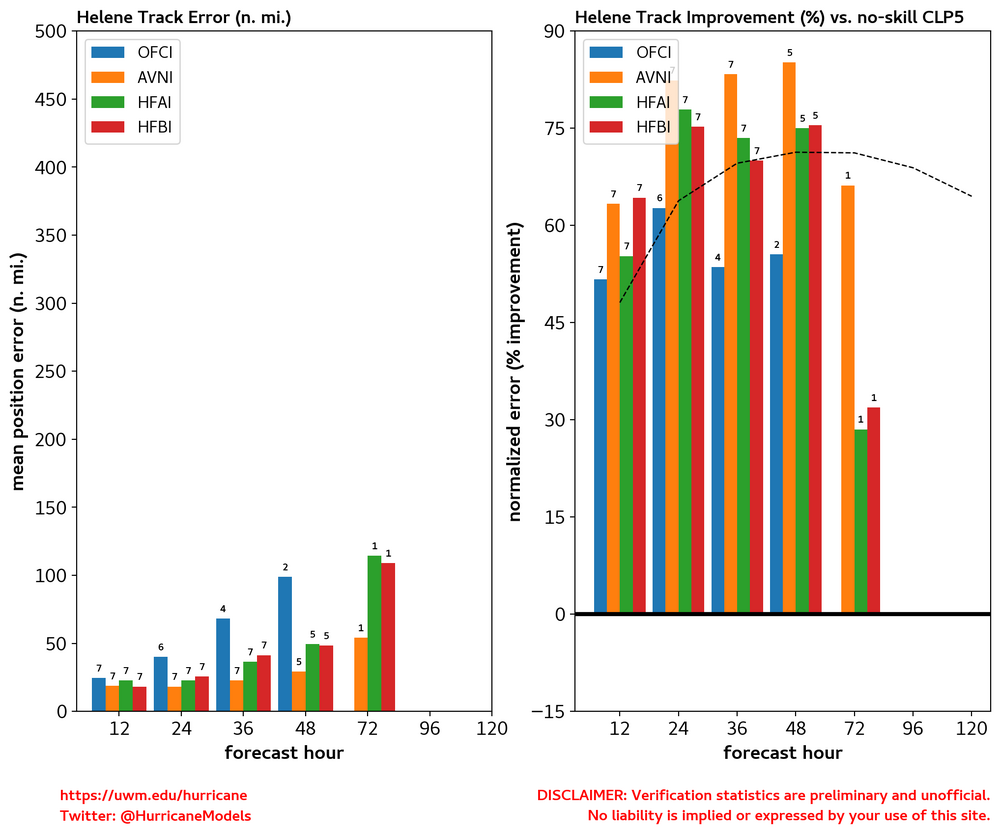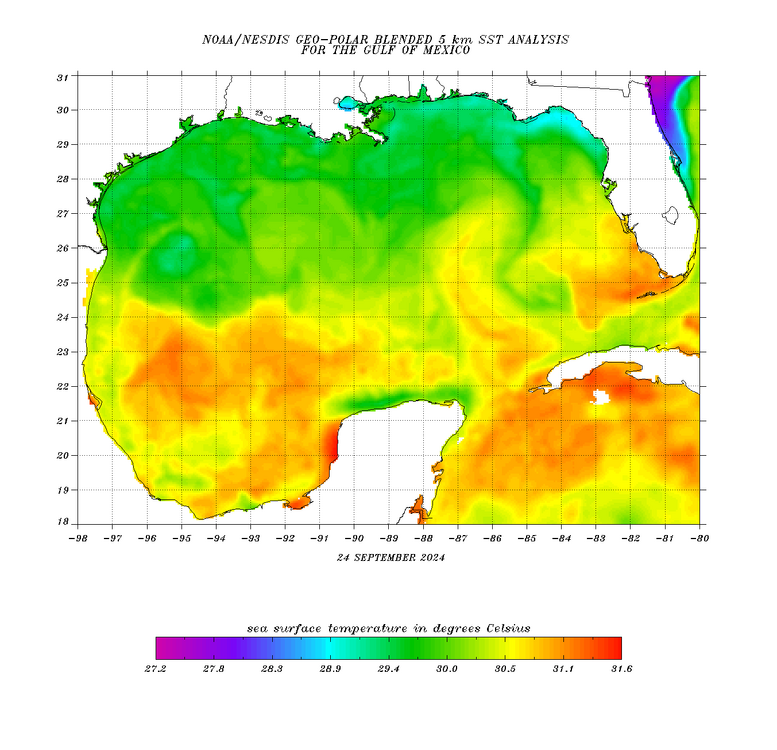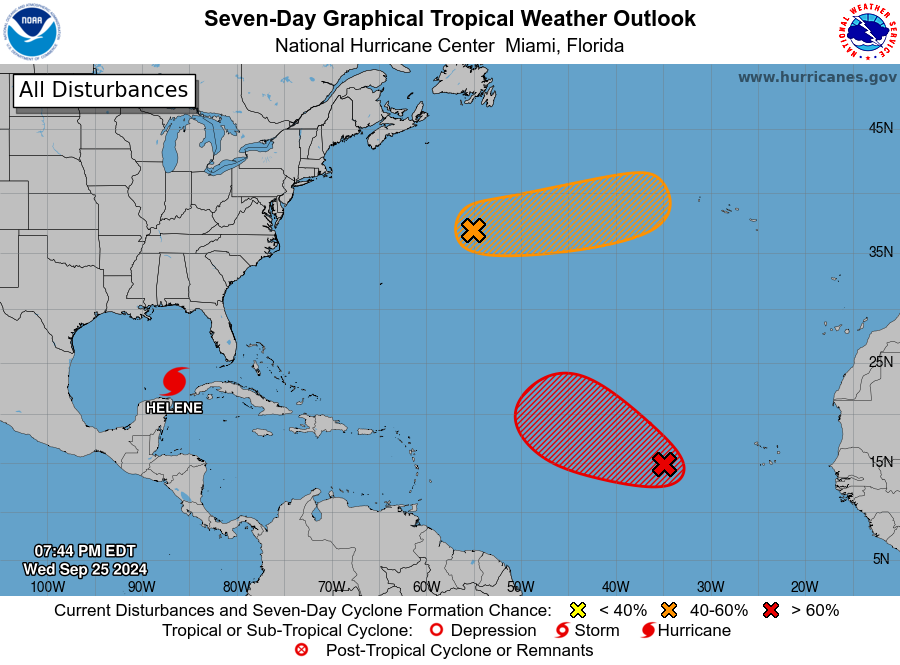-
Posts
3,336 -
Joined
-
Last visited
Content Type
Profiles
Blogs
Forums
American Weather
Media Demo
Store
Gallery
Everything posted by wthrmn654
-
Translated to 960
-
Idk it kinda looks like the western flank that builds them just vanishes. With that said, it's not near the core/ center so it may not affect it much. And some sort of weird clear blob near bottom right area of the center. I'm guessing some dry air from earlier
-
It was posted already one or 2 times look at a page or 2 before this one
-
-
Satellite images show that Helene has a well-organized appearance, with numerous convective banding features. A ragged-looking eye feature is also apparent. However, reports from both Air Force and a NOAA Hurricane Hunter aircraft investigating the system suggest that the it lacks a well-defined inner core with a somewhat broad maximum wind field for now. The central pressure has dropped a little to around 972 mb. Given the slowly falling central pressure, the intensity is maintained at 75 kt for this advisory. Helene's structure and intensity will continue to be closely monitored by Hurricane Hunter aircraft tonight and Thursday. The hurricane continues moving northward with an estimated initial motion of 360/08 kt. For the next couple of days, the steering scenario for this system remains basically unchanged from the earlier advisory. The flow between a mid-tropospheric trough over the east-central United States and a ridge over the western Atlantic should result in Helene accelerating northward to north-northeastward during the next 24 to 36 hours. This motion will bring the center of Helene to the northeastern Gulf of Mexico coast in about 24 hours. The official track forecast through landfall is very similar to the previous NHC prediction and remains close to the corrected consensus guidance. After landfall, the trough to the northwest of the tropical cyclone becomes a cutoff low, and Helene should turn leftward as it rotates around the low. In 3-4 days, the system should become a shallow extratropical cyclone within weaker steering currents. Helene should be in an atmospheric and oceanic environment over the eastern Gulf of Mexico that will be very conducive for strengthening. The system is expected to traverse the Loop Current, which has especially high oceanic heat content. This, along with fairly low vertical wind shear and a moist mid- to lower- tropospheric air mass, should likely result in rapid intensification before landfall. The official forecast continues to call for the hurricane to reach category 4 status tomorrow. It should be noted that the HAFS-A and HAFS-B regional hurricane models show even more intensification than indicated here. Helene is forecast to be a large major hurricane when it reaches the Big Bend coast of Florida. As a result, storm surge, wind, and rainfall impacts will extend well away from the center and outside the forecast cone, particularly on the east side. In addition, the fast forward speed when Helene moves inland will result in a far inland penetration of strong winds over parts of the southeastern United States, including strong gusts over higher terrain of the southern Appalachians. A higher-than-normal gust factor is indicated in the official forecast while Helene is inland.
-
SUMMARY OF 1000 PM CDT...0300 UTC...INFORMATION ----------------------------------------------- LOCATION...23.1N 86.6W ABOUT 425 MI...680 KM SW OF TAMPA FLORIDA ABOUT 465 MI...750 KM SSW OF APALACHICOLA FLORIDA MAXIMUM SUSTAINED WINDS...85 MPH...140 KM/H PRESENT MOVEMENT...N OR 360 DEGREES AT 9 MPH...15 KM/H MINIMUM CENTRAL PRESSURE...972 MB...28.71 INCHES DISCUSSION AND OUTLOOK ---------------------- At 1000 PM CDT (0300 UTC), the center of Hurricane Helene was located near latitude 23.1 North, longitude 86.6 West. Helene is moving toward the north near 9 mph (15 km/h). A northward or north-northeastward motion at a faster forward speed is expected during the next 36 hours. On the forecast track, Helene will move across the eastern Gulf of Mexico tonight and Thursday and cross the Florida Big Bend coast Thursday evening. After landfall, Helene is expected to turn northwestward and slow down over the Tennessee Valley on Friday and Saturday. Maximum sustained winds are near 85 mph (140 km/h) with higher gusts. Strengthening is forecast, and Helene is expected to be a major hurricane when it reaches the Florida Big Bend coast Thursday evening. Weakening is expected after landfall, but Helene's fast forward speed will allow strong, damaging winds, especially in gusts, to penetrate well inland across the southeastern United States, including over the higher terrain of the southern Appalachians. Hurricane-force winds extend outward up to 35 miles (55 km) from the center and tropical-storm-force winds extend outward up to 345 miles (555 km). The minimum central pressure reported by Hurricane Hunter aircraft is 972 mb (28.71 inches).
-
https://www.star.nesdis.noaa.gov/goes/floater.php?stormid=AL092024#homePageLink https://www.ospo.noaa.gov/products/ocean/tropical/floaters/09L/09L_floater.html
-
Nearest buoy last night was 87 or 88, there are 0 buoys in that region of the gulf however so have to rely solely on satellite estimates.
-
Impressive how close it got to cancan area.
-
-
Maybe be a little premature to make any calls like that just yet. By tomorrow 8 am if nothing has really changed by then I'd start to have doubts.
-

2024 Atlantic Hurricane Season
wthrmn654 replied to Stormchaserchuck1's topic in Tropical Headquarters
Anyone see that sneaky system in the northern Atlantic with 40%chance of formation? Also 2nd formation coming off of Africa. -
-
That one wrap/ sliver on the western side where there's lack of clouds would usually imply there's dry air in that location. Atleast that's how it would present itself the last few tropical systems this year.
-
Looking at the airmass composite, which is used for seeing dry air, it's still affecting it. Didn't expect to see dry air getting mixed into the equation at all honestly. ----- Current Analysis ----- Date : 26 SEP 2024 Time : 001020 UTC Lat : 23:01:15 N Lon : 86:34:59 W CI# /Pressure/ Vmax 3.8 / 979.5mb/ 61.0kt Final T# Adj T# Raw T# 3.7 3.8 3.8 Center Temp : -40.6C Cloud Region Temp : -57.1C Scene Type : EMBEDDED CENTER CLOUD REGION Subtropical Adjustment : OFF Extratropical Adjustment : OFF Positioning Method : FORECAST INTERPOLATION Ocean Basin : ATLANTIC Dvorak CI > MSLP Conversion Used : CKZ Method Tno/CI Rules : Constraint Limits : NO LIMIT Weakening Flag : ON Rapid Dissipation Flag : OFF
-
OK, by far the coolest site I've stumbled upon overall and spells the storm and actual track in motion, radar, etc tons of info. https://zoom.earth/storms/helene-2024/#overlays=crosshair
-
I see the spin and possible center on cancan radar. https://www.rainviewer.com/radars/mexico.html
-
The 00z gfs and euro ensembles have done pretty good with the short term track direction compared some of the other models.
-

Potential Tropical Cyclone Eight—50mph/1006mb
wthrmn654 replied to WxWatcher007's topic in Tropical Headquarters
Recon in 95l now -
Exactly that's what I eat heading on weather Channel, had they had a high tide at exact time of hit and maybe a little slower I think flood damage may of been 5x worse. Waters more destructive then most think
-
Overall, how did they do down south? Heard on TV wind wasn't really a thing is now water, mostly fresh water or fresh and salt? Haven't paid much attention honestly.
-
Tides are manageable thankfully minus the areas to the right and closest to center.
-
looks like lowest pressure recorded will be 976mb unless it drops more wow
-
90.6knots gust measured (104 mph)
-
station got as low as 978.6mb winds are even starting to lower pressure might be going up now but wow i expect it to go lower!









